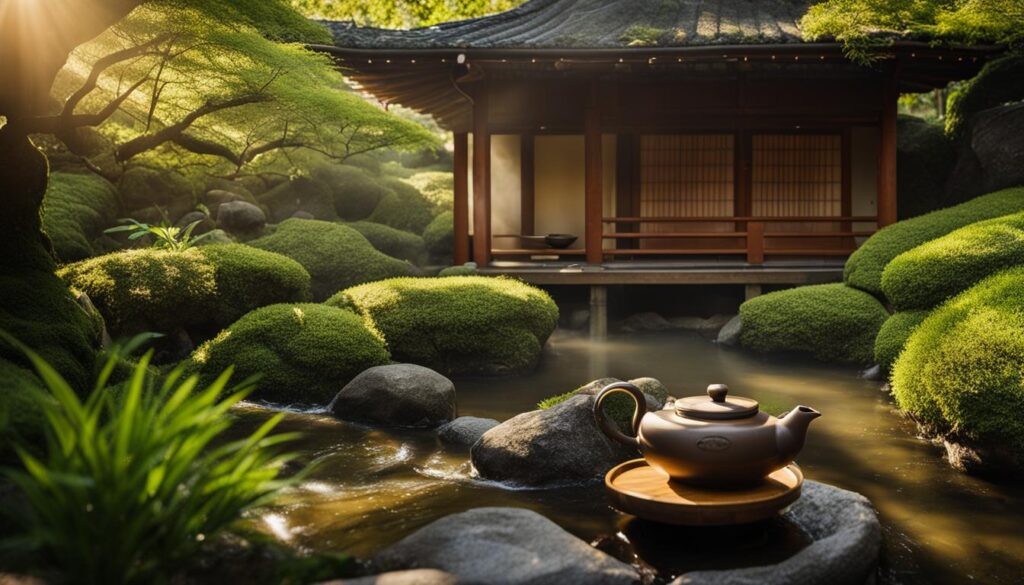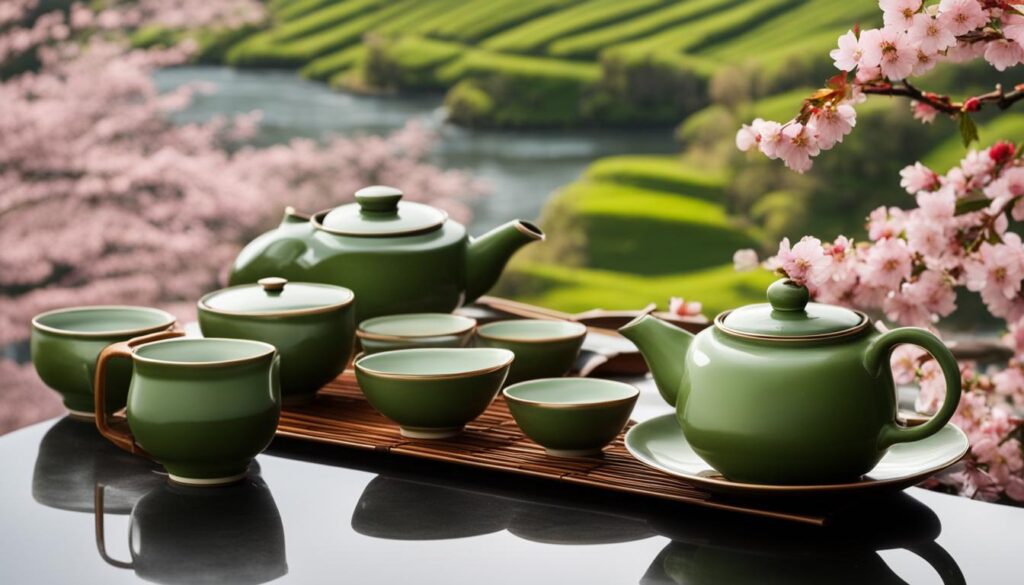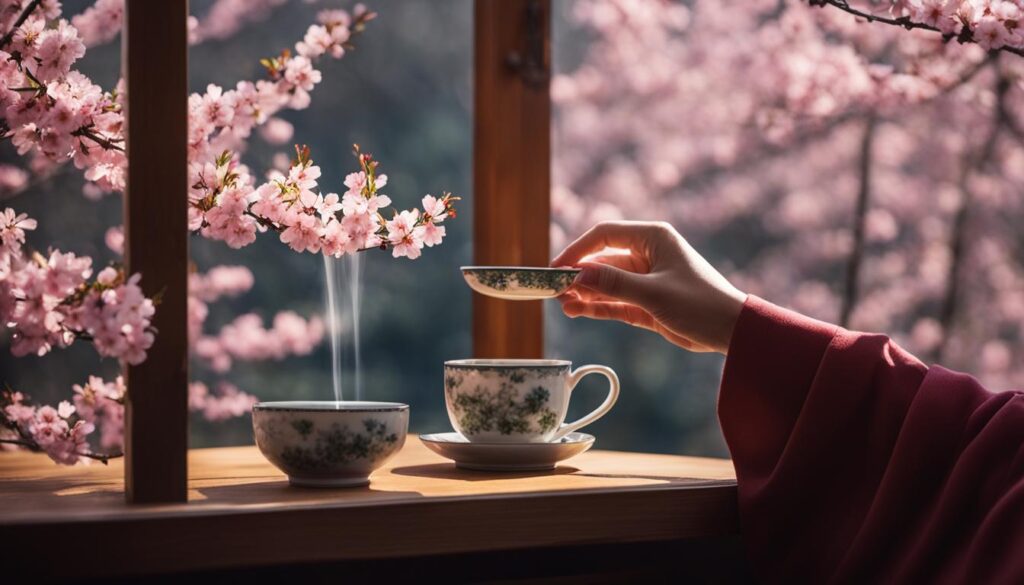As a tea enthusiast, I have always been intrigued by the world of Japanese teas. Among the various types available, one tea stands out as Japan’s most popular and beloved – sencha tea. Known for its rich flavor profile, refreshing finish, and numerous health benefits, sencha tea has captured the hearts of tea lovers worldwide.
Sencha tea is made from organic steamed green tea leaves harvested from the slopes of Mount Fuji, Japan’s iconic peak. This meticulous process ensures that the tea retains its vibrant color and delicate taste. The moment you take a sip of sencha tea, you’ll notice its distinct grassy notes and a refreshing hint of sweetness, making it a truly delightful beverage to savor.
Key Takeaways:
- Sencha tea is Japan’s most popular tea, known for its rich flavor profile and refreshing finish.
- It is made from organic steamed green tea leaves harvested from Mount Fuji, Japan.
- Sencha tea offers numerous health benefits and is rich in antioxidants.
- Brewing sencha tea is easy and can be enjoyed hot or iced.
- Sencha tea is widely available online and at specialty tea stores.
The Process of Making Sencha Tea
Sencha tea, a popular Japanese green tea, undergoes a meticulous process to preserve its vibrant flavor and distinct characteristics. Let’s delve into the fascinating process of making this refreshing and invigorating beverage.
1. Harvesting and Steaming
As soon as the tea leaves are harvested, they are quickly steamed to halt the oxidation process. This crucial step ensures that the leaves retain their vibrant green color, fresh aroma, and beneficial compounds. The steaming process varies in time and temperature, influencing the tea’s final flavor profile.
2. Rolling and Shaping
After steaming, the leaves are carefully rolled and shaped into delicate needles. This traditional technique helps preserve the tea’s structure and prevents it from losing essential oils. The rolling process also promotes the release of distinctive flavors and aroma that are characteristic of sencha tea.
3. Drying and Sorting
Once rolled, the sencha tea leaves are dried to remove excess moisture. This step further concentrates the tea’s flavor and helps maintain its freshness. Following drying, the leaves are sorted based on their size, color, and quality to ensure a consistent and superior product.

4. Sourcing and Quality
Premium sencha tea is often sourced from small single-estate farmers in Japan, particularly the Kyushu region, renowned for producing sweeter and richer varieties of sencha tea. By supporting local farmers and choosing high-quality tea, enthusiasts can experience the true essence and flavors of sencha tea.
5. Shincha: The First Harvest
The first harvest of sencha tea, known as “Shincha,” is particularly prized for its exceptional taste and aroma. Shincha is made from the freshest tea leaves of the spring harvest and embodies a delicate sweetness with a subtle hint of astringency. This limited edition tea is eagerly awaited by tea connoisseurs worldwide.
By following these intricate steps, sencha tea artisans create a beverage that delights the senses with its vibrant color, invigorating aroma, and crisp flavor. Whether enjoyed hot or iced, sencha tea offers a delightful and rejuvenating experience.
History and Cultural Significance of Sencha Tea in Japan
Sencha tea has a long and fascinating history in Japan, dating back to the 8th century when it was introduced by Buddhist monks. Initially a beverage enjoyed exclusively by nobles and priests, sencha tea gradually gained popularity across all social classes in Japan.
In Japan, the majority of tea consumed is powdered green tea known as matcha. However, in the 17th century, during a period of isolationist policies, Japan developed new methods of making tea, including sencha, gyokuro, and matcha. Sencha tea stands out for its unique steaming process, which gives it a distinct and delightful flavor profile.
“The rich and vibrant taste of sencha tea is a testament to Japan’s tea-making mastery. With its sweet, grassy, and vegetal flavors, sencha has become an integral part of Japanese culture, enjoyed daily by many.”
The cultivation and preparation of sencha tea symbolize the harmony between humans and nature. The tea leaves are carefully harvested from lush green fields, reflecting the Japanese reverence for the natural world. The process of steaming the leaves helps retain their vibrant green color and distinct flavors, ensuring a refreshing and invigorating tea experience.
Sencha tea holds immense cultural significance in Japan, representing purity, tranquility, and hospitality. It is often served to guests and visitors as a gesture of respect and warm hospitality. The tea ceremony, a ritualized way of preparing and serving tea, highlights the importance of mindfulness, grace, and harmony in Japanese culture.

The rich history and cultural significance of sencha tea in Japan make it a cherished part of daily life. Whether enjoyed in serene tea gardens, traditional teahouses, or in the comfort of one’s home, sencha tea offers a moment of calm and appreciation for the beauty of Japan’s flourishing tea traditions.
Health Benefits of Sencha Tea
Sencha tea offers numerous health benefits. It is rich in antioxidants, such as catechins and epigallocatechin gallate (EGCG), which help in fighting free radicals and reducing oxidative stress.
These antioxidants may contribute to a lower risk of various health conditions, including heart disease, type 2 diabetes, and certain types of cancer. Sencha tea also contains caffeine and L-theanine, which can improve mental alertness, focus, and mood.
It is also believed to support weight loss, boost the immune system, and promote healthy skin.
Incorporating sencha tea into a balanced diet can contribute to overall well-being.
How to Brew and Enjoy Sencha Tea
Brewing sencha tea is a delightful and straightforward process that allows you to experience the distinct flavors and aromas of this popular Japanese tea. Follow these simple steps to brew and enjoy sencha tea:
-
Measure: Use one level teaspoon of sencha tea per 8 oz cup of water. This is an ideal ratio to achieve a balanced and flavorful brew.
-
Heat the Water: Bring fresh, filtered water to a temperature of 175°F (80°C). Heating the water to this specific temperature will ensure that the delicate flavors of sencha tea are fully extracted without any bitterness.
-
Steep: Place the sencha tea leaves in a teapot or a tea infuser and pour the heated water over them. Allow the tea to steep for 1-3 minutes, depending on your preference for strength. Be sure not to oversteep to avoid the development of any bitter notes.
-
Serve: Once the steeping time is complete, strain the brewed sencha tea into your teacup. You will be greeted by a pale neon green infusion with a delightful mellow, sweet, and vegetal taste.
Sencha tea offers a unique flavor profile with notes of citrus, cooked spinach, and toast. Its refreshing and invigorating taste makes it suitable for every season. Whether you enjoy it hot or iced, sencha tea is a versatile beverage that can be paired with light and savory dishes or simply savored on its own.
For a truly authentic and zen experience, consider brewing sencha tea using traditional Japanese tea ceremony techniques or using a kyusu teapot, specifically designed for brewing Japanese green teas. This will enhance the overall sensory experience and allow you to fully appreciate the nuances of this exceptional tea.

Where to Buy and Reviews of Sencha Tea
Looking to buy sencha tea? You’re in luck! Sencha tea is widely available for purchase both online and at specialty tea stores. To ensure the quality and authenticity of your sencha tea, it is essential to source it from reputable sellers.
When buying sencha tea online, there are many options to choose from. Numerous online retailers offer a wide range of sencha teas, including varieties from different regions and cultivars. It’s worth exploring these options to find the sencha tea that suits your preferences.
Before making a purchase, consider reading reviews from fellow tea enthusiasts. These reviews can provide valuable insights into the flavor profiles and quality of different sencha teas. By considering the experiences of others, you can make a more informed decision and potentially discover new brands or varieties to try.
So, whether you’re looking to replenish your sencha tea stock or embark on a new sencha tea adventure, take the time to explore reputable online vendors and read reviews to ensure a satisfying and authentic sencha tea experience.
FAQ
What is Sencha tea?
Sencha tea is Japan’s most popular drink, made from organic steamed green tea leaves harvested from Mount Fuji, Japan. It is known for its rich, refreshing, and crisp taste.
What are the health benefits of Sencha tea?
Sencha tea is rich in antioxidants, such as catechins and epigallocatechin gallate (EGCG), which help fight free radicals and reduce oxidative stress. It may lower the risk of heart disease, type 2 diabetes, and certain types of cancer. Sencha tea also contains caffeine and L-theanine, which can improve mental alertness, focus, and mood. It is also believed to support weight loss, boost the immune system, and promote healthy skin.
How do you brew and enjoy Sencha tea?
To brew Sencha tea, use one level teaspoon of tea leaves per 8 oz cup of water. Let it steep in hot water (175°F) for 1-3 minutes. The brewed tea will have a pale, neon green color and a mellow, sweet, and vegetal taste with notes of citrus, cooked spinach, and toast. Sencha tea can be enjoyed hot or iced, making it suitable for any time of the year. It can be paired with light and savory dishes or enjoyed on its own for a refreshing and invigorating experience.
Where can I buy Sencha tea and find reviews?
Sencha tea is widely available for purchase online and at specialty tea stores. It is important to source Sencha tea from reputable sellers to ensure quality and authenticity. Many online retailers offer a wide range of options, including different regions and cultivars. Reading reviews from fellow tea enthusiasts can provide insights into the flavor profiles and quality of different Sencha teas.